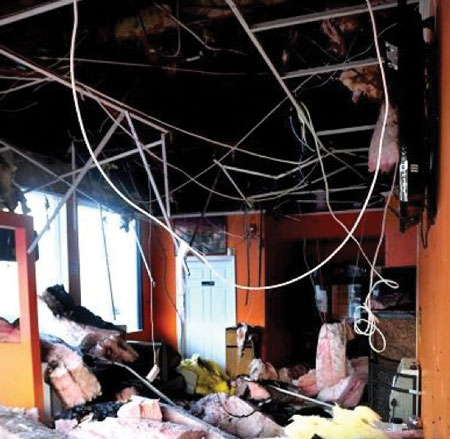
By Josh Miller and Frank Ricci
Since the advent of the fire service, life safety has stood as its number-one commandment. The environment that our victims face is dynamic, toxic, and hostile. Our job is to implement proper strategies and tactics. The enemy-fire-has the element of surprise; it chooses the “battlefield” and “sets the sand in motion.” The only way to stop it is to remove the victim to definitive care. Proper staffing and aggressive tactics help ensure the victim’s best chance for survival.
Victim Synopsis
Our greatest moment is when we save a life. Victim survival is predicated on many factors that we cannot control such as building construction, fuel loads, and notification of alarm. Compartment size, layout, and door orientation also can be the difference between life and death. Recognize that you may not be able to save a viable victim in every situation. However, by coordinating fire attack, ventilation, search, and command with proper staffing, you increase your chances of “making that grab.”
RELATED FIREFIGHTER TRAINING
- Civilian Rescue: The Reason We Exist
- Search That Saves Lives
- Sizing Up the Search Effort
- Search Mission Prep: Size-Up, Methods, and Tools
In some cases, even when it appeared that all might be lost, victims were nevertheless rescued. Public fire education that has renewed the focus on sleeping with bedroom doors closed has had an impact. Proper size-up in a well-involved structure fire is key to recognizing areas of the structure that you can still aggressively search, even in marginal situations.
Over the past 40 years, the places where we find victims, mainly in bedrooms and exit paths, have stayed fairly consistent. Each year, populations of victims who are unable to act make our task more unpredictable. This population includes young children, the impaired, and the disabled. Another group that is problematic is those who may act irrationally, such as getting into a tub or hiding in a closet or under a bed.
As the First Line Goes, So Goes the Fire
Getting the first line in place is not enough! Yes, for firefighter safety and saving property, the first line’s placement is critical, and it has saved more lives than any other fireground action. We also suggest when making complicated stretches that command marries companies to complete the job. This line also protects against fire travel that could further endanger victims.
Some circumstances dictate using a 2½-inch handline from the start to control the fire or prepare for the volume of fire you may face. In turn, choosing the right line coordinated with command, ventilation, and search will facilitate quality searches. Get this line in place quickly and efficiently by involving a second company. Do not hesitate to ask command for an additional company to complete this task. However, just getting the line in place is not enough.
 |
| (1, 2) Notice the condition of the floor after the ceiling has been pulled. Performing a quick search will prevent covering a victim. (Photo 1 courtesy of New Haven Independent. Photo 2 by Justin McCarthy.) |
When viewing the fireground through the lens of the rapid intervention team, finding the fire and “playing” water greatly reduce the chance of a noncardiac combat line-of-duty death (LODD). So, what about the victims? Even with the line in place, the products of combustion are still present. Getting the first line in place and completing the primary search are the only things that can make the difference!
If you are assigned to the truck or rescue company, you have no place on a line; your job is to search and ensure searches are declared through command. If you’re fixated on a need to flow water, it’s time to move back to the engine. There will only be one or a few trucks and rescues on scene that are dedicated to search. However, there will be numerous engines to get lines in place. Common sense plays a role here; even though the line is not your priority, do not pass a kink without fixing it.
When on the engine and advancing a line, search as you go, especially stair landings; it takes only one second to make sure a victim is not inches away. Victims are often found in exit paths, and now you are advancing on that same path. If you chock a door, ensure that you do not cover another door or are not overlooking a victim. When visibility is hindered, there is a natural tendency to get up when moving the line into place. Resist this urge; remember, this is about the victim and your safety. Push ahead as low as possible, and search as you go. Speed is critical here, and containing the fire is one of the first benchmarks in controlling the building.
Missing Victims
You are on scene to find victims, so why would firefighters walk into a building before visibility improves and no searches are declared? This happens in almost every department, and it is the result of complacency-complacency that can kill. Not only can you fall into a shaft or a burned-out hole in a floor, but you may end up missing a victim. Remember, you can’t trip if you’re crawling, and crawling is the best possible position for finding the victim. Pay attention; you hear several news stories each year of search crews missing victims. This is inexcusable and embarrassing, and it reflects on our entire service!
Covering the Victim
More than 20 year ago, our city missed a victim in a vacant structure fire. Six months later, the Bureau of Alcohol, Tobacco, Firearms and Explosives and our marshal’s office were training an arson dog in the burned-out structure. The dog kept going into a bathroom (the dog was not a cadaver dog but still hit on the room). They found the victim in the tub and covered with the pulled ceiling. While doing research for this article, we discovered many news reports of missed victims covered by pulled ceilings and moved furniture.
Hasty Searches
We have implemented hasty searches as a member of the truck company and reinforced it as a boss (company officer) on an engine. Now, our entire department trains on the need for this tactic before pulling ceilings. Note: Delaying pulling a ceiling for a few seconds will not cause the fire to take control of the structure, especially when a line is close by. The search is not declared over the radio, and it has no impact on the primary or secondary search. It does, however, allow the boss to get a good view of his surroundings and allows the truck (in optimal conditions) to ensure it will not cover a victim. If you encounter a drop ceiling, do not pull the track; this will only lead to your members becoming entangled in wires.
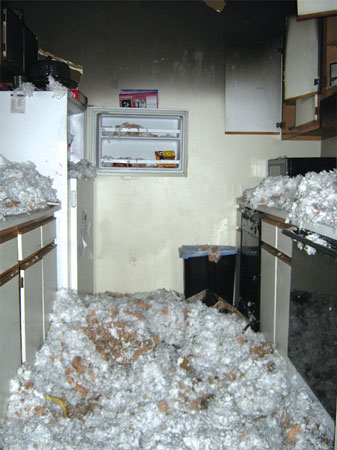 |
| (1, 2) Notice the condition of the floor after the ceiling has been pulled. Performing a quick search will prevent covering a victim. (Photo 1 courtesy of New Haven Independent. Photo 2 by Justin McCarthy.) |
You can also employ a hasty search when you find a victim in a bed. Always sweep the rest of the bed to ensure the victim was sleeping alone. Bunk beds are coming back in style, so always run your hands down the headboard or the footboard to ensure that you don’t miss the top bunk. These actions are critical in all bedrooms.
Move Furniture to an Area Already Searched
In the past, we have erred by moving furniture to an unsearched area that covered a deceased dog. This incident greatly impacted our need for tactical excellence by ensuring that no animal or victim is left behind. If you must move furniture, move it along a wall where you have already searched. Do not move objects on top of a bed; they may fall between the bed and the wall. This action will also ensure that you don’t cover a door, a window, or a victim.
The layout of a room’s furniture allows you to reach the center of the room and to orient while you search. Yes, you want to “map” the room, noting the location of windows and staying on the wall. However, you can, for example, also leave the wall to go around a couch and search around a coffee table. As long as the furniture stays in place, the table leads back to the couch and then to the wall. Opening doors without searching behind them can impede your chance of success.
In many small homes, a bedroom door can cover a closet. If a door is chocked open, search behind it for the secondary search. Also make sure to check behind a door you chock open. We have found side doors in ranch houses that open to cover the basement door, and we have seen illegally renovated doors that cover bedroom doors.
VES/VEIS Not the Question
Adding the “I” (isolate) to vent-enter-search (VES) does not change the tactic. However, the data from the new science now dictate that we consider how and when to break a window. VES has always been about isolating your location. Although “flow path” was not the coined phrase of the day, any competent firefighter knew that closing the door was a priority. What we didn’t fully understand before the National Institute of Standards and Technology and Underwriters Laboratories study was how fast the flow path can move. The old method of breaking the glass with the ladder can place your team at a disadvantage and draw fire into the room faster. Consider laddering the window, mask and gear up, climb the ladder, and then clear the entire window from the top of the ladder. This may save you only 30 seconds, but it could mean the difference between having the time to close the door and getting a quick look into the hall and being chased out by fire. Don’t turn your rescue into a recovery! Sweep the floor before you sound.
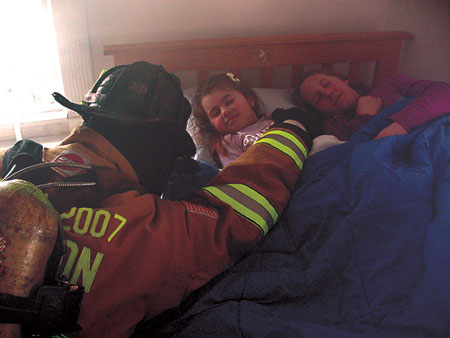 |
| (3) Two children are sleeping in the same bed. (Photo by Justin McCarthy.) |
Remember where you find your victims. “Belly in” places you in the action position; it allows you to stay below the neutral plane and keeps your body from contacting broken glass. It also minimizes the chance of losing balance and falling before completing entry. Note: It’s acceptable to take a window with a ladder in a non-VES situation. If the interior companies are making a push toward the seat of the fire and they need the window vented quickly, they are allowed to break a window with a ladder as long as it is coordinated properly with the inside division. Keep your head down to avoid being hit with falling debris, and wear gloves to prevent lacerations from glass sliding down the rails.
Corner Trick for VES
This tactic will work in more than 99 percent of corner bedrooms. If, on entering, you move away from the outside corner of the house, you will get to the door more quickly. It doesn’t matter if you enter from the back, side, or front; in a small house, the path of travel may only be a few feet of difference. In mid-size or large homes, the benefit may be more than five to 10 feet. Saving a few feet of travel may make the difference between closing the door and completing the search.
Marginal Situations
In some situations, the building will be lost. However, some locations can be searched quickly when there is a victim who can be viable. In one such situation, a house was well involved with fire blowing through the roof. It was clear that this home would be in the dumpster by morning. As the crew was stretching a 2½-inch handline for a defensive operation, the officer determined that he should check behind the front door and use the thermal imaging camera to check the adjoining living room. He located two victims that crews were able to pull out. Crews then went imminently defensive. VES is a great tactic for marginal situations. Note: In this situation, there is no way to isolate the search. Your only option is controlling the door to the living room or bringing in the line to make the quick grab.
Rethinking Conventional Search Without a Line
In 2006, we started teaching nationally on the need to rethink conventional search. It was amazing that the same firefighters who would lambast a junior member for not closing the door on a VES operation would enter a room during conventional search, leave the door open, and vent the windows. The building doesn’t know whether or not you’re venting from the inside or the outside; you are creating a flow path and operating in it.
Still, today, we see articles, books, and classes that teach keeping the door open and leaving a member at the door to check for deteriorating conditions. This is a self-fulfilling prophecy, and there is no way to reconcile this with our latest understanding of fire dynamics. When you take the window, you are drawing the fire to your location-you are now in the flow path.
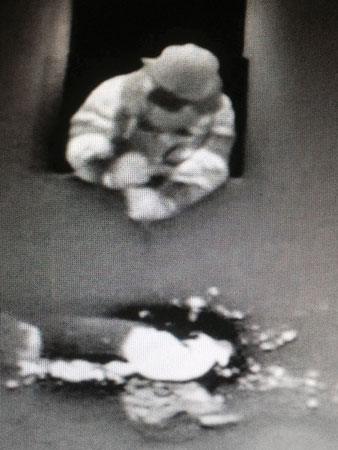 |
| (4) Sounding can turn a rescue into a recovery. [Photo from “Tactical Perspective Search” DVD (Fire Engineering).] |
When you enter the room, shut the door! This accomplishes a few critical tactical objectives. First, you can still leave a member at the door to direct the search. It is acceptable to split up as long as you’re in some form of contact, including voice. Venting a window will not impact the flow path.
The room will also lift, facilitating a quicker search and allowing conditions in the room to improve quickly. With the door closed, the member searching will be able to stand momentarily to search a crib or bunk bed. We have conducted anecdotal research that shows conditions will improve in the room. However, now that science has advanced, we hope to see future research measure the drop in temperature as well as the reduction of toxic gases such as carbon monoxide, hydrogen cyanide, and a host of others that impede the victim’s chance of survival. We can quantify the increase of oxygen when we take the windows with the door closed.
This tactic creates an area of refuge, thereby benefiting firefighters. There is little chance of a member being able to close the door after fire enters the threshold. Note: A firefighter bailing out the window is a failure at every level. Make sure that any bailout simulator has a door that can be closed; this will help create muscle memory. Closing the door is key; even a hollow-core door will buy the firefighter some time, and it could be the difference between putting up a ladder to rescue the firefighter vs. bailing out.
Venting for Life
This type of ventilation can only be performed if you can isolate your location. If you are in a living room or kitchen, chances are you cannot isolate your location. This means that you can’t take any windows until the line is in place. After a fire, you can always tell the proficiency of the search crew by viewing the hand marks on the wall at window height. This tells you that they are mapping their search and making note of critical features.
Forcible Entry Is Ventilation
Air moves fire; water does not if the stream is tight and applied properly. When you force the door or a window, you create a flow path. When you arrive and leave the front door open and you prepare your stretch, you are feeding the fire oxygen; this equates to energy. Take a second and make sure the door is not locked, and check behind it for a victim before closing it.
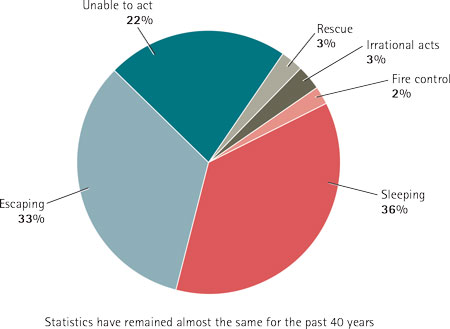 |
| Figure 1. Civilian Fire Deaths by Activity Based on 40 Years of National Fire Protection Association Data (Inset: Courtesy of Emergency Training Solutions, LLC.) |
If you are on the truck and you decide to initiate a search, make sure the door is unlocked, and close it behind you. This way, you will deny the fire energy. The fire does not differentiate between openings. It is better to keep the environment rich until the hose team puts water on the seat of the fire. When breaking glass, attack the check rail at the corner with a sensible level of aggression. This is quicker than breaking the panes above and below before attacking the check rail.
The Blitz Attack and Search
Originating in Chicago, this offensive strategy is also called a “transitional attack.” It is yet another tool in the toolbox, but it should not be the default play at every fire. If fire is enveloping the building or blowing out the front door or proper staffing is not on scene to coordinate the attack, water can be played from the exterior as crews begin their stretch. As soon as the hose team reaches the front door or the floor below the main body of fire, they should shut down the outside line.
An unconscious victim has never been saved inside a structure fire by a crew standing on the outside! If you’re the incident commander or the first-due boss and you decide to put the fire in check, you must calculate the time it will take to transition to an interior strategy. The time the victim has in this environment is only minutes! It is the equivalent of an hourglass nailed to the table. “Hitting it hard from the yard” is not the only trick in your bag; other tactics such as door control can control the energy going to the fire. Departments have arrived on scene and stretched a line to the front of the house to hit the fire from the outside, and then they moved to the rear to hit it again. This action (or lack of action) would have doomed any possible victim in the house. Even stretching to the rear for a quick attack and then moving through the front door could doom a victim. Not every fire is ventilation limited, and aggressive departments around the nation have been making rescues by coordinating tactics to perform interior operations for years.
You must resist a visceral response that perverts the science and completely changes what has proven to work for the victims and us. National Institute for Occupational Safety and Health reports for LODDs show that failures leading to LODDs are a culmination of many factors, not just a failing to understand the environment. We believe in the science and, if implemented properly and with regard for the victim, we can improve our tactical disposition.
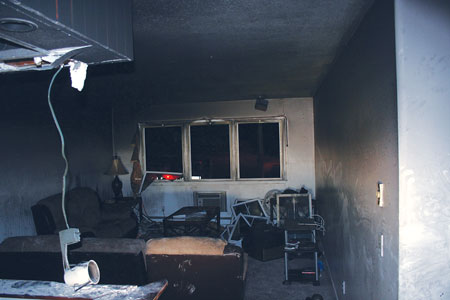 |
| (5) Hand marks on the wall mapping the room (right). When crawling, make sure to have a hand on the wall to map windows and doors. (Photo by Justin McCarthy.) |
Hostile Search
We covered the engine company members starting their search as they advance. However, the opposite is true for the truck. Find the fire first, and then search back. Notify command or the division boss of the location. Teaneck (NJ) Fire Department Battalion Chief Joe Berchtold taught us that hooking your foot on the doorframe will ensure that you can reach five feet into the fire room to search. This provides a safeguard so that, if the room flashes, you can rapidly exit while being in the best position to close the door. You can use this search in small bathrooms as well. You must not crowd the hall when the truck is locating and searching the fire room.
Breaking the Panic
If you are fortunate enough to have a panicked occupant on the exterior screaming for you to save his loved ones, have him aid in your search. People tend to repeat themselves when they’re under stress; it is up to you to break this cycle. Ask a direct question, such as the following:
- Where is the victim located?
- What floor is the victim on?
- What room is the victim in, and how old is he? (We have all heard stories of the “baby” who was 30 years old and weighed 250 pounds.)
Rooming House Fires
As the economy worsens, the need for our service grows. Rooming houses can be found in any community and in any style home. Often described as “common kitchen and bathroom,” each floor has bedrooms that are often locked by a padlock high on the door. Although a locked padlock can indicate that the occupant is out, it is not uncommon for an occupant to lock his kids in a room for their own safety. For the primary search, force the fire room and both adjoining rooms. For the secondary search, force and search all rooms.
 |
| Figure 2. The “Corner Trick.” |
Declaring Searches
You would not buy property without seeing it, right? So, why do we hear over the radio that the primary or secondary is complete without noting the geographic location? If you search the second floor and are assigned the primary search, you would take responsibility only for what you searched (i.e., “Truck 4 Irons to Division 2: Primary search of the second floor complete”).
Finding the Victim
If you locate the victim and he is conscious, you may elect to close the door and move him to a window. If he is unconscious, bring him out the front door even if it requires going down the stairs. If you locate one victim, keep in mind that there may be others. Notify the boss, and don’t hesitate to pass the victim to another team. You already know what hasn’t been searched. If you bring the victim all the way out, you may be hindering the rest of the search.
Search Training
Conduct your training using vacant structures, or set up a burn building with old furniture and use a smoke machine and multiple victims to increase your proficiency. Searching a burn building with no furniture is problematic and does not prepare members for what they will face. Also, do not leave command out of these drills.
All of our skills are perishable. Training and drilling will increase your ability to safely, efficiently, and effectively make the grab.
JOSH MILLER is a firefighter for the New Haven (CT) Fire Department, assigned to Truck 4, and a volunteer with the Hyattsville (MD) Fire Department. Miller previously served with the District of Columbia Fire Department, assigned to Engine 32. He began his career as a volunteer with the Briarcliff Manor (NY) Fire Department.
FRANK RICCI is an advisory board member for Fire Engineering and FDIC. He is the drillmaster for the New Haven (CT) Fire Department and co-host of “Politics & Tactics” on BlogTalkRadio. Ricci is a contributing author to the Safety and Survival chapter of Fire Engineering’s Handbook for Firefighter I and II. He won a landmark fire service case, testifying before the U.S. Supreme Court. Ricci has been a lead consultant for several Yale University studies and has worked on a heavy rescue unit covering Bethesda and Chevy Chase, Maryland. Ricci has filmed several Fire Engineering Training Minutes segments and has authored several DVDs including the Firefighter Survival Techniques and Tactical Perspectives series. He is the author of Command, Ventilation, Search, Fire Attack, and Mayday, (Fire Engineering).
Frank Ricci will present “Effecting the Rescue Through Aggressive Tactics: ‘It’s Your Turn to Make the Grab’” on Wednesday, April 20, 10:30 a.m.-12:15 p.m., at FDIC International 2016 in Indianapolis.
Using Vent-Enter-Isolate-Search Tactics
Search in Burning Buildings: Plan for Success
Size Up Before You Search
More Fire Engineering Issue Articles
Fire Engineering Archives

